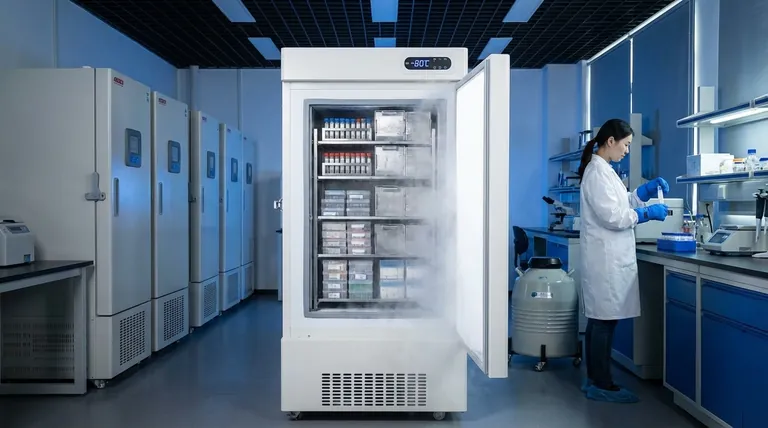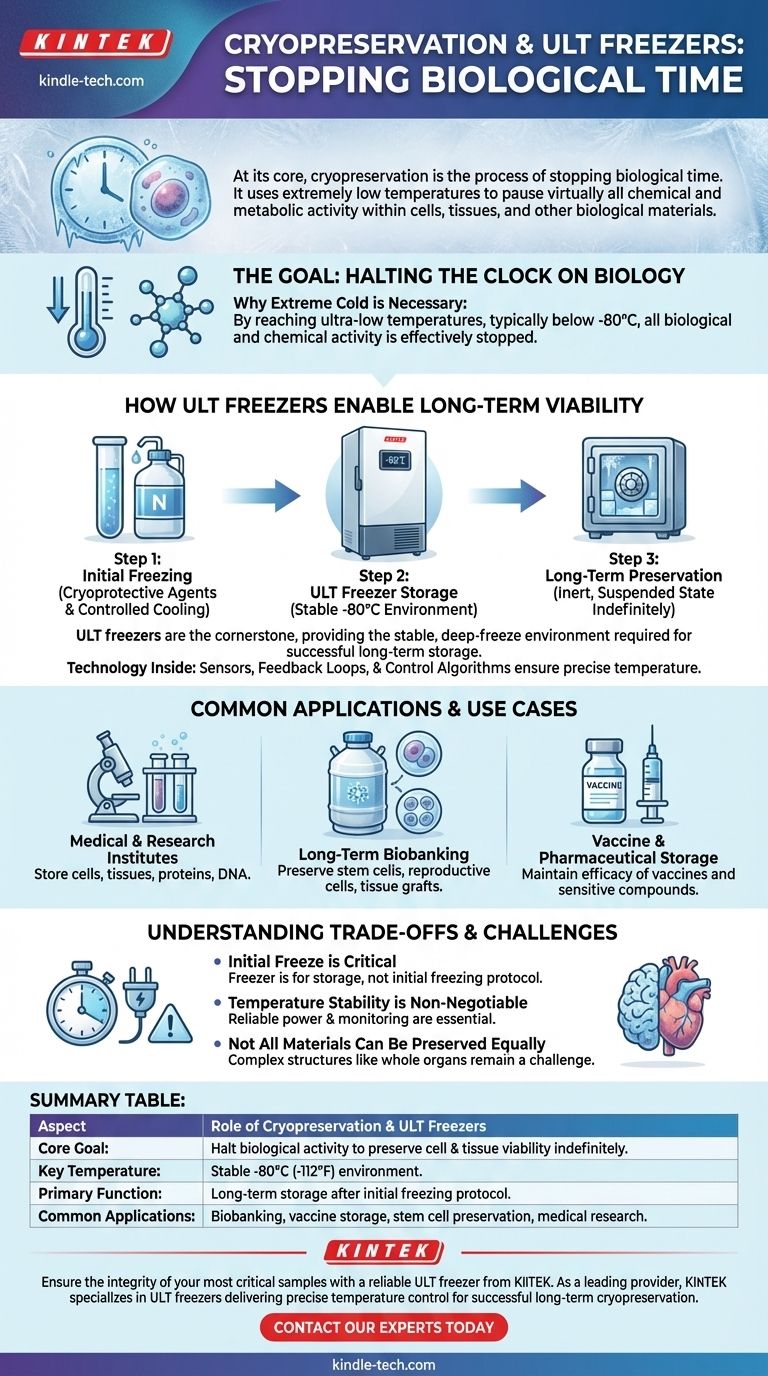At its core, cryopreservation is the process of stopping biological time. It uses extremely low temperatures to pause virtually all chemical and metabolic activity within cells, tissues, and other biological materials, preserving them in a state of suspended animation. Ultra-low temperature (ULT) freezers are a cornerstone of this process, providing the stable, deep-freeze environment required for the successful long-term storage of these invaluable samples.
The central challenge in preserving biological material is preventing the cellular decay that begins almost immediately. Cryopreservation solves this by using extreme cold to halt this process, with ULT freezers acting as the secure vaults that maintain this state for years or even decades.

The Goal of Cryopreservation: Halting the Clock on Biology
What is Cryopreservation?
Cryopreservation is a sophisticated technique for preserving the viability of biological samples by cooling them to sub-zero temperatures.
The process almost always involves the use of cryoprotective agents. These are compounds that act like a biological antifreeze, protecting cells from the damage caused by ice crystal formation during freezing.
Why Extreme Cold is Necessary
At normal temperatures, enzymes and chemical reactions cause biological materials to degrade. Cooling slows these processes down.
By reaching ultra-low temperatures, typically below -80°C, all biological and chemical activity is effectively stopped. This allows samples to be preserved in a static state, preventing decay and maintaining their integrity for future use.
How ULT Freezers Enable Long-Term Viability
The Critical Storage Phase
While the initial freezing of a sample might involve other methods like exposure to liquid nitrogen, the ULT freezer is essential for the long-term storage phase.
Its purpose is to provide an unwavering, intensely cold environment that ensures the preserved material remains in its inert, suspended state indefinitely.
Maintaining a Stable -80°C Environment
ULT freezers are engineered to maintain internal temperatures at or below -80°C (-112°F). This specific temperature range is the industry standard for halting the degradation of most biological samples.
The stability of this temperature is just as important as the cold itself. Fluctuations can compromise the integrity of the stored materials over time.
The Technology Inside
Modern ULT freezers achieve this stability through a combination of sensors, feedback loops, and control algorithms.
These systems constantly monitor the internal temperature and precisely adjust the cooling system to maintain the target temperature with minimal deviation, ensuring the safety of the contents.
Common Applications and Use Cases
Medical and Research Institutes
ULT freezers are indispensable in hospitals, research institutes, and biomedical facilities. They are used to store a vast range of materials, including cells, tissues, proteins, enzymes, and DNA.
Long-Term Biobanking
These freezers are critical for biobanks that store materials for future use. This includes preserving stem cells, reproductive cells (sperm and ova), and tissue grafts for transplantation or fertility treatments.
Vaccine and Pharmaceutical Storage
Many modern vaccines and sensitive pharmaceutical compounds require storage at ultra-low temperatures to maintain their efficacy. ULT freezers provide the necessary environment for both storage and distribution logistics.
Understanding the Trade-offs and Challenges
The Initial Freeze is a Separate, Critical Step
A common misconception is that the ULT freezer performs the entire process. The freezer's role is storage, not the initial freezing protocol.
The success of cryopreservation is highly dependent on the correct initial cooling rate and the proper application of cryoprotective agents before the sample ever enters the ULT freezer.
Temperature Stability is Non-Negotiable
The primary risk in long-term storage is temperature fluctuation. A power outage or mechanical failure can be catastrophic, leading to the loss of irreplaceable samples.
For this reason, ULT freezers require reliable power sources, backup systems, and constant monitoring to ensure they remain within their target temperature range.
Not All Materials Can Be Preserved Equally
Cryopreservation is incredibly successful for individual cells and simple tissues. However, preserving complex structures like whole organs remains a significant scientific challenge due to the difficulty of preventing ice crystal damage throughout a larger mass.
Making the Right Choice for Your Goal
The strategy for preservation is dictated entirely by the nature of the sample and the intended timeline.
- If your primary focus is short-term research: A ULT freezer is the gold standard for preserving the integrity of sensitive cells, proteins, or reagents between experiments.
- If your primary focus is long-term biobanking: A high-quality, monitored ULT freezer is non-negotiable to ensure the viability of irreplaceable samples like stem cells or tissues for decades.
- If your primary focus is preserving vaccines or biologics: You must use a ULT freezer specifically validated for medical use to guarantee the stability and efficacy of the stored materials.
Ultimately, ULT freezers are the silent guardians that make modern biological research, advanced medicine, and fertility science possible.
Summary Table:
| Aspect | Role of Cryopreservation & ULT Freezers |
|---|---|
| Core Goal | Halt biological activity to preserve cell and tissue viability indefinitely. |
| Key Temperature | Stable -80°C (-112°F) environment. |
| Primary Function | Long-term storage after initial freezing protocol. |
| Common Applications | Biobanking, vaccine storage, stem cell preservation, and medical research. |
Ensure the integrity of your most critical samples with a reliable ULT freezer from KINTEK.
As a leading provider of laboratory equipment, KINTEK specializes in ultra-low temperature freezers designed for the demanding needs of research, biobanking, and pharmaceutical storage. Our freezers deliver the precise temperature control and stability required for successful long-term cryopreservation, protecting your invaluable biological materials.
Ready to find the perfect preservation solution for your lab? Contact our experts today to discuss your specific requirements and discover how KINTEK can support your laboratory's success.
Visual Guide

Related Products
- 158L Precision Vertical Ultra Low Freezer for Laboratory Applications
- 408L Advanced Vertical Laboratory Ultra Low Temperature Freezer for Critical Research Material Preservation
- 808L Precision Laboratory Vertical Ultra Low Temperature Freezer
- 208L Advanced Precision Laboratory Ultra Low Temperature Freezer for Cold Storage
- 308L Precision Ultra Low Temperature Freezer for Laboratory Applications
People Also Ask
- What advantages do ultra-low temperature freezers offer? Ensure Long-Term Sample Integrity and Reliability
- What makes Ultra-Low Temperature freezers energy efficient? Key Design & Operational Strategies
- What temperature range do Ultra-Low Temperature freezers maintain? The -80°C Standard for Sample Integrity
- What are the common applications of ultra-low temperature freezers? Preserve Your Most Valuable Samples
- What are ultra-low temperature freezers designed for? Preserving Your Most Valuable Biological Samples



















